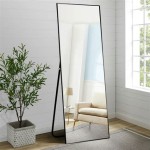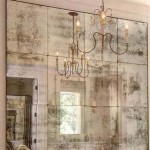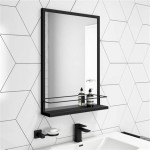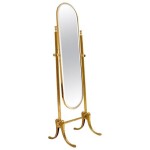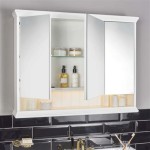Creating a DIY Wood Frame for Your Mirror: A Comprehensive Guide
Mirrors are essential decorative elements in many homes, enhancing the sense of space and reflecting light to brighten interiors. While readily available in various styles, commercially produced mirrors often lack the unique character and personalized touch that a custom-made frame can provide. Crafting a wood frame for a mirror offers a compelling DIY project that allows for complete design control, resulting in a bespoke piece perfectly tailored to individual preferences and home decor. This article will provide a detailed guide to creating a wood frame for a mirror, covering key aspects from planning and material selection to construction and finishing.
Planning and Design Considerations
Before embarking on the construction phase, meticulous planning is crucial. This involves accurately measuring the mirror, determining the desired frame dimensions, selecting the wood type, and finalizing the frame's design. Neglecting this preliminary stage can lead to errors and ultimately detract from the final product's aesthetic appeal and structural integrity.
The first step is to accurately measure the mirror. Using a reliable measuring tape or ruler, measure the length and width of the mirror at several points to account for any slight variations. The largest measurements should be used to ensure the frame is slightly larger than the mirror, providing a comfortable fit. Adding approximately 1/8 to 1/4 inch to each dimension will allow for slight adjustments during assembly and prevent the mirror from being too tightly wedged within the frame.
Next, decide on the desired width and thickness of the frame. The width will determine the frame's visual presence, while the thickness will influence its sturdiness and how it interacts with the wall if it is to be hung. Consider the size of the mirror and the overall aesthetic you are aiming for. Larger mirrors can typically accommodate wider frames, while smaller mirrors may benefit from more delicate and narrow frames. The frame's thickness should be adequate to support the mirror's weight and prevent warping or bending.
The choice of wood profoundly impacts the frame's appearance and durability. Softwoods like pine are relatively inexpensive and easy to work with, making them suitable for beginners. However, they are more prone to dents and scratches. Hardwoods such as oak, maple, and walnut offer greater durability and a more refined aesthetic, but they can be more challenging to cut and shape and generally more expensive. Consider the desired finish and the existing decor of the room when making your wood selection. For example, a rustic-themed room might benefit from reclaimed wood, while a more contemporary space might call for a sleek hardwood like walnut.
Finally, sketch out the frame design. Will it be a simple rectangular frame, or will it incorporate decorative elements such as molding, beading, or carved details? Consider the method of joining the frame pieces together. Common options include mitered corners (45-degree angled cuts), butt joints (simple end-to-end connections), and lap joints (overlapping pieces). Mitered corners offer a clean, professional look but require precise cutting. Butt joints are easier to execute but may require additional reinforcement. Lap joints provide a strong connection but are more visually prominent. Also, think about how the mirror will be secured within the frame. Common methods include using mirror clips, glues specifically designed for mirrors, or creating a rabbet (a groove cut into the inside edge of the frame) to hold the mirror in place.
Construction Techniques and Material Handling
Once the planning stage is complete, the construction phase begins. This involves cutting the wood pieces to the correct dimensions, joining them together to form the frame, and preparing it for finishing. Safety precautions are paramount, and appropriate personal protective equipment, such as safety glasses and ear protection, should be worn throughout the construction process.
Cutting the wood accurately is essential for a well-fitting frame. A miter saw is ideal for making precise angled cuts for mitered corners. A circular saw or table saw can be used for straight cuts, such as those needed for butt joints or rabbets. Ensure the blade is sharp and appropriate for the type of wood being used to prevent splintering or tear-out. Measure and mark the wood carefully before each cut, and double-check the measurements to avoid errors. When cutting mitered corners, ensure the angle is precisely 45 degrees to create a seamless joint.
The method of joining the frame pieces will depend on the chosen design. For mitered corners, wood glue and clamps are essential. Apply a thin, even layer of glue to both mating surfaces and clamp the pieces together securely. Use corner clamps to ensure the corners are square and aligned properly. Wipe away any excess glue with a damp cloth. For butt joints, wood glue and screws or nails can be used. Pre-drill pilot holes before inserting screws to prevent the wood from splitting. For lap joints, wood glue and screws or nails can also be used, or the joint can be secured with mortise and tenon joinery for a stronger and more traditional look.
Creating a rabbet involves cutting a groove into the inside edge of the frame to accommodate the mirror. This can be done using a router with a rabbeting bit or a table saw with a dado blade. The rabbet should be slightly wider and deeper than the thickness of the mirror to allow for easy insertion and removal. Ensure the rabbet is consistently sized around the entire frame to prevent the mirror from sitting unevenly.
After the frame is assembled, sand all surfaces smooth. Start with a coarser grit sandpaper (e.g., 80 or 100 grit) to remove any imperfections or rough edges, and then gradually move to finer grits (e.g., 150 or 220 grit) to achieve a smooth, polished surface. Pay particular attention to the joints, ensuring they are flush and seamless. Remove all sanding dust with a tack cloth or vacuum before proceeding to the finishing stage.
Finishing and Mirror Installation
The final stage involves applying a finish to the wood frame to protect it and enhance its appearance, followed by safely installing the mirror within the frame. Selecting the appropriate finish is crucial for both aesthetic and functional reasons.
There are several finishing options available, each with its own set of advantages and disadvantages. Paint offers a wide range of color choices and can be easily applied with a brush, roller, or spray gun. Choose a paint specifically designed for wood and apply several thin coats, allowing each coat to dry completely before applying the next. Varnish provides a durable, protective layer that enhances the wood's natural grain. It is available in various sheens, from matte to gloss. Apply varnish in thin, even coats with a brush or spray gun, following the manufacturer's instructions carefully. Stain penetrates the wood and enhances its natural color and grain. It is available in a wide range of colors and can be applied with a brush or cloth. After applying the stain, wipe away any excess with a clean cloth. Oil finishes, such as linseed oil or tung oil, penetrate the wood and provide a natural, warm appearance. They are relatively easy to apply and maintain but may require multiple coats for optimal protection. Polyurethane provides a durable, water-resistant finish that is ideal for high-traffic areas. It is available in various sheens and can be applied with a brush or spray gun.
Before applying any finish, it is essential to prepare the surface properly. Ensure the wood is clean, dry, and free from dust or debris. Apply a primer to help the finish adhere better and provide a more uniform color. Sand lightly between coats of finish to remove any imperfections and create a smooth surface. Follow the manufacturer's instructions carefully for the specific finish being used, paying attention to drying times and application techniques.
Once the finish has dried completely, the mirror can be installed into the frame. If a rabbet was created, carefully slide the mirror into the groove. Secure the mirror in place with mirror clips, which are small metal or plastic fasteners that hold the mirror against the frame. Position the clips evenly around the perimeter of the mirror, ensuring they are securely attached to the frame. Alternatively, a specialized mirror adhesive can be used to glue the mirror to the rabbet. Apply the adhesive in thin beads around the perimeter of the mirror, ensuring it does not squeeze out onto the front of the mirror. Allow the adhesive to dry completely according to the manufacturer's instructions.
If the mirror will be hung on the wall, attach suitable hanging hardware to the back of the frame. D-rings and picture wire are a common option. Ensure the hardware is securely attached to the frame and can support the weight of the mirror. Alternatively, keyhole hangers can be used for a more flush mount against the wall. Consider the type of wall and use appropriate anchors or screws to securely attach the mirror to the wall. Ensure the mirror is level before tightening the screws completely.
By following these steps, individuals can create a unique and personalized wood frame for their mirrors, adding a touch of craftsmanship and style to their homes. The project, while demanding attention to detail, provides a rewarding experience and a lasting piece of decor.

Diy Farmhouse Wood Frame Mirror She Gave It A Go
Diy Wood Frame Mirror Farmhouse Industrial Bathroom Joyfully Treasured

How Build A Wooden Diy Mirror Frame For Entryway Thediyplan

Wood Mirror Diy Shanty 2 Chic

Diy Rustic Wood Frame Mirror Amanda Katherine

Diy Farmhouse Wood Frame Mirror She Gave It A Go

Beautiful Diy Driftwood Mirror Do It Yourself Fun Ideas

Diy Wood Framed Bathroom Mirror Christina Maria Blog

Mirror Frame Diy How To Update A Basic Bathroom Our Faux Farmhouse

How To Build A Diy Frame Hang Over Bathroom Mirror Love Our Real Life


